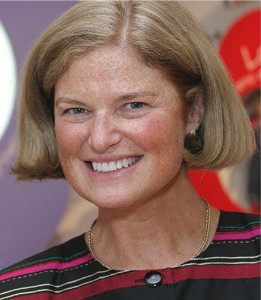 Valerie Tripp is best known for her American Girl historical fiction characters Felicity, Elizabeth, Josefina, Samantha, Nellie, Kit, Ruthie, Emily, and Molly. The following is her interview with Cracking the Cover coinciding with the release of American Girl’s latest historical fiction character, Maryellen.
Valerie Tripp is best known for her American Girl historical fiction characters Felicity, Elizabeth, Josefina, Samantha, Nellie, Kit, Ruthie, Emily, and Molly. The following is her interview with Cracking the Cover coinciding with the release of American Girl’s latest historical fiction character, Maryellen.
Have you always wanted to be a writer? Why?
Though I’ve always loved thinking up stories, writing is hard work for me. I’m persnickety and slow. I think I came to writing as a job because my favorite thing in the world is reading. (Don’t you love books and stories and just immersing yourself in the world of a book?) Writing allows me to use my imagination, and I am grateful to have a job that requires me to create something new all the time. It’s a great challenge.
Why do you write for young readers?
I write for young readers because I think that there’s something about being involved in children’s literature that nurtures optimism. You just can’t help it. Children are the very embodiment of promise and potential (wacky though they are) and those of us lucky enough to be involved in children’s literature are right there, right on the spot, to witness how books and stories nourish their growth. I know that writing for children in-and-of-itself is an optimistic act of cheerful trust in transformation, a leap of faith that out of chaos will emerge order, story, maybe even that ping moment of recognition and connection. And all of us who are lucky enough to hand books and stories to children know that we are changing their lives. Is there anything more wonderful than saying to a child, “You’re going to love this book! And guess what? There’s more where that came from!”? Children’s books leave an indelible imprint. They shape and color and influence the way a child perceives the world. The books we read as children serve as a measure of all the books that follow. Children’s books construct the readers’ characters, their view of the world, their ideas of the purpose and challenge of life. Books stretch children’s brains and hearts and give them a sense of themselves as unique beings with contributions to make. Books spark interests, feed passions, ignite ambitions. They are an ongoing reliable source of entertainment, education, rest, and refreshment. The books you give children introduce those children to characters and therefore, teach the children empathy and compassion. I saw where a recent study says fiction improves one’s ability to understand others. And so does nonfiction, of course! Nonfiction stories have heart and emotion, in addition to of course providing facts that give a child a sense of mastery and curiosity, and give children a sense that they, too, can contribute to their community, whether it’s friends and family or the world. Nonfiction can teach children about other cultures, religions, tastes, mores, senses of humor so that they will connect and feel and hear and experience the excitement of discovery.
And writing books for children also helps them learn how to express themselves in written language so that they may connect with others and discipline themselves to articulate what is in their minds and hearts.
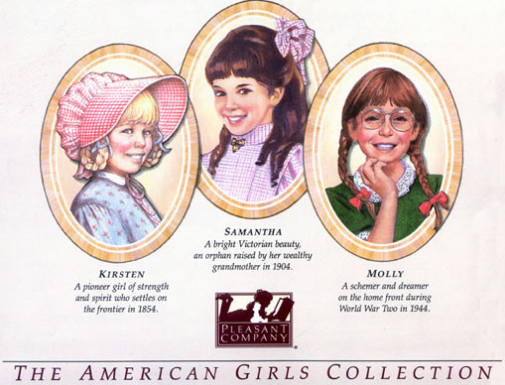 How did you become involved with American Girl?
How did you become involved with American Girl?
A year after I graduated from college, after I’d worked as a saleslady and a copy editor in Boston, I was hired by Pleasant Rowland to write songs, stories, plays, nonfiction essays, and skills book pages for a reading program called “The Superkids.” While Pleasant and I worked on the reading program together, we talked about the books we had loved as girls. Then Pleasant married and moved to Wisconsin and I married and moved to South Carolina. One day the phone rang and it was Pleasant. “I’ve had a great idea!” she said. Her great idea was American Girl: books about girls who lived in different periods of history written for readers of the same age as the characters. It has been my life’s privilege and delight that Pleasant trusted me to be the first “voice” of American Girl. In 1983, I wrote the first outlines of the stories for Kirsten, Molly, and Samantha. As the years went on and American Girl grew, I wrote about Felicity, Josefina, and Kit as well as the characters’ best friends: Emily, Nellie, Elizabeth, and Ruthie – and now Maryellen! So I began writing my American Girl books before American Girl existed, in a way, and it was all due to my friendship with Pleasant Rowland, the creator of American Girl. By the way, Pleasant and I still work on The Superkids; we’re revising it, which is tremendous fun.
How did you come to write the Maryellen books?
Oh, I have always wanted to write about a character that lived in the 1950s. I was born in 1951, so it has been particularly delightful and poignant to research, reflect upon, and rediscover the 50s. My mother often said, “After the Depression and World War 2, all we wanted was a house and a big, happy, healthy family.” Just like Maryellen, I am the middle child in a big, boisterous, baby-boom family so I know how much fun– and what a challenge – it is. Like Maryellen, I struggled to stand out singly while being a good member serving the group. Writing Maryellen’s story allowed me to do what American Girl does best: show how 50s trends such as the burgeoning of suburbia, big families, geographic and economic mobility, new technology such as TV and rockets, rock’n’roll, fear of the atomic bomb, lingering post-war prejudice, advertising, and the Cold War shaped the life of one girl, and to make the 50s matter to my readers because Maryellen is their friend.
By the way, the Florida setting was pure delight. Because her stories took place in Florida, I knew that Maryellen’s personality would be warm, sunny, colorful, and friendly! Florida was also the perfect state for the Larkin family to live in because the 50s had such an impact there. The population boomed, the tourist industry bloomed, and from Cape Canaveral, rockets took off and zoomed! Maryellen and her family live in one of the thousands of housing developments that sprang up in Florida in the 50s, in a “cookie cutter” house that looks like all the others in the development, which is a metaphor for how outside appearances do not tell the truth about differences within. I loved having the ocean nearby, because it is the perfect metaphor for endless possibilities beyond the horizon and the excitement of waves of change.
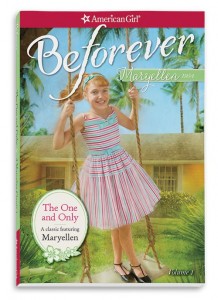 What comes first, the book or the doll?
What comes first, the book or the doll?
With Maryellen, as with all the historical fiction characters in the American Girl series, the character comes before the doll. I begin with research, and research the books by immersing myself in the time period the character lives in. I read everything I can find both fiction and nonfiction, I watch movies, listen to music, travel to where the character lived, go to historical restorations, look at art, and talk to experts as well as people who lived during the period, too, if possible. Research doesn’t begin or end; it is a way of life. It turns out that the universe is full of the information you need – you just have to begin to pay attention to it! Once I feel that I have a grasp on the major issue of the period I know what my character’s personality will be. That is, my character’s personality is a girl-sized version of the major issue of the time. In Maryellen’s case, I felt that central dilemma was conformity vs. individuality.
Of course, my historical research is only half of the story. I love researching by observation the issues that matter to girls of today. Every story I write makes a connection between girls of today and the characters I write about from the past. Some issues have changed, but some issues about growing up are the same no matter when a girl lives. I am constantly impressed and inspired by the strength and creativity, intelligence, industriousness, and kindness of the women I read about in my research. Those women, and the girls I meet and get letters from today – my readers – are the inspiration for my stories. I think of my readers as the personification of promise. I take them seriously, and I write my stories to say to them, “Look how cool the world is! Be observant! Dive in! Have experiences – and remember them. You are creating the world we will all live in, so be thoughtful, alert, and compassionate.”
As always, I am grateful to my readers; they are my inspiration in every way. In Maryellen’s circumstances, their inspiration was specific: Maryellen has had polio, and that is because of the many, many girls I have met at schools, libraries, book stores, scout troops, and church groups or who have written to me and have asked me to write about a character who is differently abled. They asked me to show that the character’s physical or developmental challenge is not what defines her. It is but one trait among many that make her who she is as an individual. Because Maryellen had polio, one leg is weaker than the other and her parents worry about her heart and her breathing. But the stories make it clear that polio does not define Maryellen. She is also smart, left-handed, funny, thoughtful, energetic, redheaded, messy, and good at drawing. Polio has taught Maryellen compassion, determination, and never to judge by outward appearance. I know that my readers will understand that polio, rampant in the 50s, is a metaphor for any unfair wallop that life surprises you with.
American Girl is extremely popular. What’s it like being the author behind a number of the characters?
When I write, I do so without thought for how many girls will read the story. I think of one delighted girl; if I can please a reader or make her stop and think or laugh or reconsider an opinion – that’s why I write.
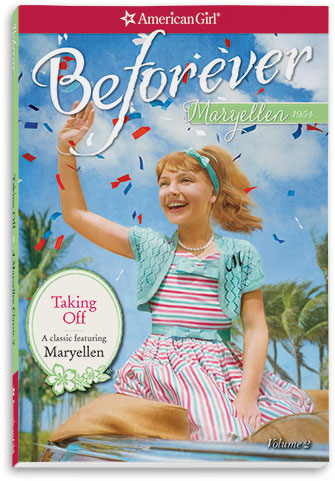 What challenges did you face writing about the 1950s?
What challenges did you face writing about the 1950s?
Though challenging, it was also rewarding to acknowledge common perceptions and stereotypes about the 50s, and then proceed to explode them! I worked hard to show how varied women’s roles were through Maryellen’s mother, her older sister Joan, and herself. People dismiss the 50s as a time of homogeneity, when in fact, its zeitgeist of “peace and prosperity” nurtured, nourished, and gave rise to tremendous growth and change. I chose conformity vs. diversity as the central dilemma of the 50s, and had Maryellen be torn over and over again between self-assertion and cooperation. She confronts the questions we all ask ourselves every day: When is it right for me to go off on my own unique and merry way and when should I put my desires aside and serve others? How can I stand up for myself but accommodate others, too? While I was writing, Maryellen helped me realize that there is no one, right answer to those questions. Rather, the conflict is healthy, ongoing, and can be fruitful. Maryellen showed me that tolerance, which is a combination of optimism, forgiveness, humility, and love, is best. She showed me the virtue of listening.
Where does Maryellen come from? Is she based on anyone in particular?
Maryellen, as all my characters, is a mix of all the girls I’ve ever met – plus a little bit of myself! She is not based on anyone in particular. (Not like Kit, for example, who was based on my mother.) Maryellen is her own quirky and unique self! Her personality was inspired by the times she lived in – the optimistic, energetic 1950s, which were a period of growth and change in the United States. Generous, smart, curious, creative, active, imaginative, earnest, and very, very funny – that’s Maryellen! Her ebullient optimism mirrors that of the U.S.A. in the 1950s; to Maryellen, everything is possible! She comes at the world with open arms, an open mind, and an open heart. Her enthusiasm gets her into pickles and predicaments even though it’s always motivated by kindness and affection for her family, friends, and community. And if she’s just a bit impulsive, messy, and scattered, well, that’s because like many artists she’s passionately interested in so many things. In creating her personality, I was inspired by the energy, industriousness, and ingenuity of the 1950s and by the many girls I have met – including my own daughter – who love to sketch and construct in three dimensions, and who are fascinated by invention, flight, and innovation. Their ideas don’t always fly, but they’re always fun.
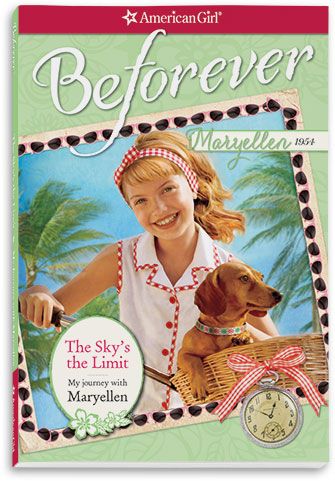 Why do the books appeal to girls?
Why do the books appeal to girls?
I think the stories appeal to girls because they are fueled by understandable humor, shared experience, and common aspirations. They contain relatable mischief and joy, and they offer friendship. They tap into imagination, which is of course a branch of hope — the ability to imagine different outcomes, different circumstances, a different life, a different self. They engage children readers where they are, meet their interest, ability, comprehension, and background existing knowledge. But above all, the stories show respect for the reader. Readers are smart enough to understand that in the Kit books, the Depression is a metaphor for any loss. Readers saw that my character Josefina’s aunt Tía Dolores was like a stepmother – so they understood Josefina’s divided loyalties. Molly’s dad went away to war, and their own parents went away to war or to look for jobs. My young readers are sharp. I think they like the books because the books provide them with vicarious experiences.
Pleasant has made my heart proud by saying that her favorite book is Josefina Learns A Lesson because it articulated something she had not realized, but loves, and that passage is when Tia Dolores says to Josefina: Reading is a way to hold onto the past, to travel to places you’ve never been, and to learn about worlds beyond your own time or experience. Emotion is the captivator and the driving force is friendship. I always think, “My story must be intimate and infinite, unique and universal.”
How has the evolution of American Girl changed what you do?
As a writer, the evolution of American Girl and its longevity led to one of my greatest challenges: to make Maryellen a character worthy to stand with her BeForever sisters. I brought to bear all that I have learned about writing since my first books came out in 1987. My first readers are grown up now. I call them “my alums,” and many of them have daughters of their own. They tell me how the adventurous and thoughtful American Girl characters helped, inspired, and befriended them. I took their messages to heart, and worked hard to make Maryellen’s stories equally compelling, worth sharing with both my alums and their daughters.
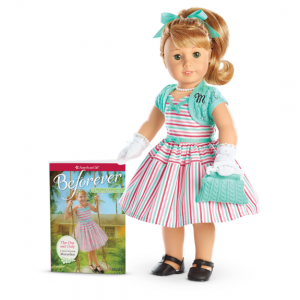 How is Maryellen’s story relevant to girls today?
How is Maryellen’s story relevant to girls today?
The central dilemma of the 1950s – conformity vs. diversity – will resonate with girls today because it is their dilemma, too. Girls are barraged with messages and images. Just as Maryellen does, a girl today has to figure out who she is, all by herself alone, and how she can use her talents for self-expression AND be a generous, contributing member of her family and community. I hope Maryellen will bolster girls’ self-confidence and remind them to celebrate the ways they are different, and find how they can put their unique abilities to use for their own joy and to make the world better. Maryellen will say to readers, “Be yourself. Challenge assumptions!” Readers will have to read both volumes to see how she works it all out and triumphs by being herself – the one-and-only Maryellen Larkin!
Do you have a favorite American Girl character?
Well, my favorite is usually the character I’m writing about at the time – IF she is cooperating with me! Sometimes a character and I have quite a tussle as I try to write the story! Right now, I am writing a mystery about Josefina, and we are having a great time together. But the answer to your question is, no, I don’t have one favorite character. I often think that my job is a healthy outlet for multiple personality disorder; it is a great pleasure to me to become each one of my characters and live in her world and speak in her voice and give her problems to solve. I love all my girls!
Is there a book from your own childhood that still resonates with you today?
When I was in the third grade, my sister Rosie bought me a Scholastic book called “Understood Betsy” by Dorothy Canfield Fisher. It is still one of my favorite books. “Understood Betsy” and “The Sherwood Ring” by Elizabeth Marie Pope are the reason why I write historical fiction. I also loved –and still love and reread — every single book by E.B. White, Beverly Cleary, Laura Ingalls Wilder, Jane Austen, Charlotte Bronte, George Eliot and thousands of others. One writer you may not expect also resonates continuously with me and has had a great influence: Eleanor Roosevelt wrote a great deal, and she has been a help to me in writing about Kit (who lived during the Depression) and Molly (who lived during WW2) and Samantha, who grew up in the same time as she did. I was lucky enough become fascinated with Eleanor Roosevelt when I was eleven, and I have been reading what she wrote and what was written about her ever since. I am an omnivorous reader; I always have three books going at once. Just now, I am reading a book about Soviet Collectives in the late 1930s, the letters of E.B. White, and a novel by Barbara Pym called “Excellent Women.” I also read a lot of poetry.
